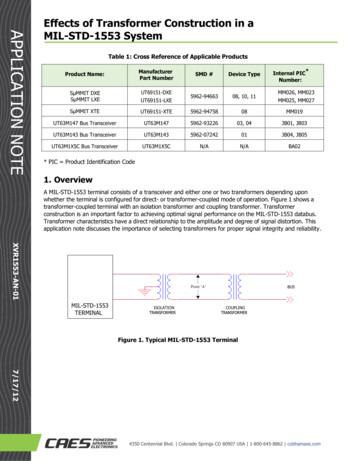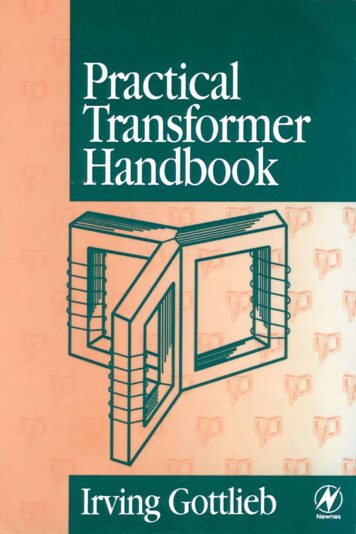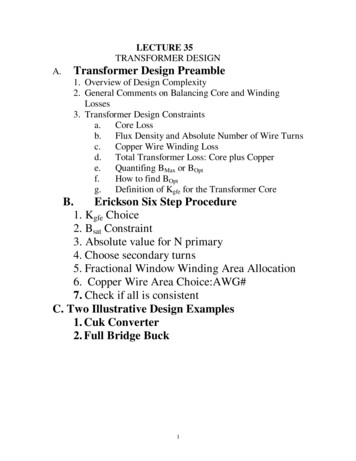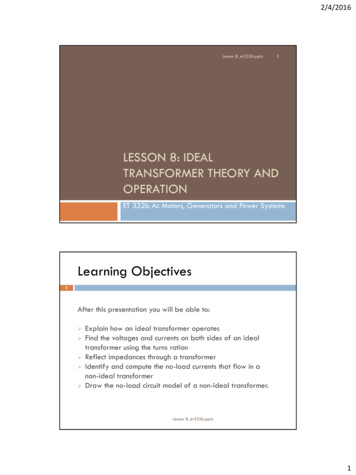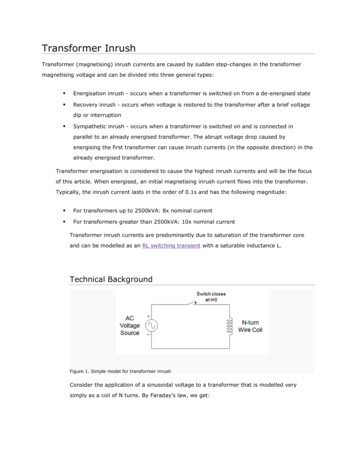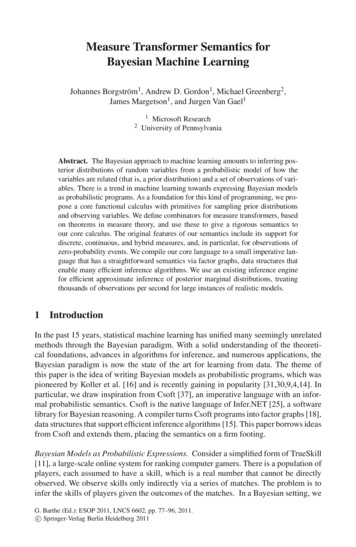
Transcription
Measure Transformer Semantics forBayesian Machine LearningJohannes Borgström1, Andrew D. Gordon1, Michael Greenberg2,James Margetson1, and Jurgen Van Gael112Microsoft ResearchUniversity of PennsylvaniaAbstract. The Bayesian approach to machine learning amounts to inferring posterior distributions of random variables from a probabilistic model of how thevariables are related (that is, a prior distribution) and a set of observations of variables. There is a trend in machine learning towards expressing Bayesian modelsas probabilistic programs. As a foundation for this kind of programming, we propose a core functional calculus with primitives for sampling prior distributionsand observing variables. We define combinators for measure transformers, basedon theorems in measure theory, and use these to give a rigorous semantics toour core calculus. The original features of our semantics include its support fordiscrete, continuous, and hybrid measures, and, in particular, for observations ofzero-probability events. We compile our core language to a small imperative language that has a straightforward semantics via factor graphs, data structures thatenable many efficient inference algorithms. We use an existing inference enginefor efficient approximate inference of posterior marginal distributions, treatingthousands of observations per second for large instances of realistic models.1 IntroductionIn the past 15 years, statistical machine learning has unified many seemingly unrelatedmethods through the Bayesian paradigm. With a solid understanding of the theoretical foundations, advances in algorithms for inference, and numerous applications, theBayesian paradigm is now the state of the art for learning from data. The theme ofthis paper is the idea of writing Bayesian models as probabilistic programs, which waspioneered by Koller et al. [16] and is recently gaining in popularity [31,30,9,4,14]. Inparticular, we draw inspiration from Csoft [37], an imperative language with an informal probabilistic semantics. Csoft is the native language of Infer.NET [25], a softwarelibrary for Bayesian reasoning. A compiler turns Csoft programs into factor graphs [18],data structures that support efficient inference algorithms [15]. This paper borrows ideasfrom Csoft and extends them, placing the semantics on a firm footing.Bayesian Models as Probabilistic Expressions. Consider a simplified form of TrueSkill[11], a large-scale online system for ranking computer gamers. There is a population ofplayers, each assumed to have a skill, which is a real number that cannot be directlyobserved. We observe skills only indirectly via a series of matches. The problem is toinfer the skills of players given the outcomes of the matches. In a Bayesian setting, weG. Barthe (Ed.): ESOP 2011, LNCS 6602, pp. 77–96, 2011.c Springer-Verlag Berlin Heidelberg 2011
78J. Borgström et al.represent our uncertain knowledge of the skills as continuous probability distributions.The following probabilistic expression models the situation by generating probabilitydistributions for the players’ skills, given three played games (observations).// prior distributions, the hypothesislet skill() random (Gaussian(10.0,20.0))let Alice,Bob,Cyd skill(),skill(),skill()// observe the evidencelet performance player random (Gaussian(player,1.0))observe (performance Alice performance Bob) //Alice beats Bobobserve (performance Bob performance Cyd) //Bob beats Cydobserve (performance Alice performance Cyd) //Alice beats Cyd// return the skillsAlice,Bob,CydA run of this expression goes as follows. We sample the skills of the three players fromthe prior distribution Gaussian(10.0, 20.0). Such a distribution can be pictured as abell curve centred on 10.0, and gradually tailing off at a rate given by the variance, here20.0. Sampling from such a distribution is a randomized operation that returns a realnumber, most likely close to the mean. For each match, the run continues by samplingan individual performance for each of the two players. Each performance is centredon the skill of a player, with low variance, making the performance closely correlatedwith but not identical to the skill. We then observe that the winner’s performance isgreater than the loser’s. An observation observe M always returns (), but represents aconstraint that M must hold. A whole run is valid if all encountered observations aretrue. The run terminates by returning the three skills.A classic computational method to learn the posterior distribution of each of the skillsis by Monte Carlo sampling [21]. We run the expression many times, but keep just thevalid runs—the ones where the sampled skills correspond to the observed outcomes. Wethen compute the means of the resulting skills by applying standard statistical formulas.In the example above, the posterior distribution of the returned skills has moved so thatthe mean of Alice’s skill is greater than Bob’s, which is greater than Cyd’s.Deterministic algorithms based on factor graphs [18,15] are an efficient alternative toMonte Carlo sampling. To the best of our knowledge, all prior inference techniques forprobabilistic languages, apart from Csoft and recent versions of IBAL [32], are basedon nondeterministic inference using some form of Monte Carlo sampling. The benefitof using factor graphs in Csoft is to support deterministic but approximative inferencealgorithms, which are known to be significantly more efficient than sampling methods,where applicable.Observations with zero probability arise commonly in Bayesian models. For example, in the model above, a drawn game would be modelled as the performance of twoplayers being observed to be equal. Since the performances are randomly drawn froma continuous distribution, the probability of them actually being equal is zero, so wewould not expect to see any valid runs in a Monte Carlo simulation. (To use MonteCarlo methods, one must instead write that the absolute difference between two drawnperformances is less than some small ε .) However, our semantics based on measure
Measure Transformer Semantics for Bayesian Machine Learning79theory makes sense of such observations, and corresponds to inference as achieved byalgorithms on factor graphs.Plan of the Paper. We propose Fun:– Fun is a functional language for Bayesian models with primitives for probabilisticsampling and observations (Section 2).– Fun has a rigorous probabilistic semantics as measure transformers (Section 3).– Fun has an efficient implementation: our system compiles Fun to Imp (Section 4),a subset of Csoft, and then relies on Infer.NET (Section 5).Our main contribution is a framework for finite measure transformer semantics, whichsupports discrete measures, continuous measures, and mixtures of the two, and alsosupports observations of zero probability events.As a substantial application, we supply measure transformer semantics for Fun, Imp,and factor graphs, and use the semantics to verify the translations in our compiler. Theorem 2 establishes the correctness of the translation from Fun to Imp and the factorgraph semantics of Imp.We designed Fun to be a subset of the F# dialect of ML [36], for implementationconvenience: F# reflection allows easy access to the abstract syntax of a program. Allthe examples in the paper have been executed with our system, described in Section 5.We end the paper with a description of related work (Section 6) and some concludingremarks (Section 7). A companion technical report [5] includes: detailed proofs; extensions of Fun, Imp, and our factor graph notations with array types suitable for inferenceon large datasets; listings of examples including versions of large-scale algorithms; anda description, including performance numbers, of our practical implementation of acompiler from Fun to Imp, and a backend based on Infer.NET.2 Bayesian Models as Probabilistic ExpressionsWe present a core calculus, Fun, for Bayesian reasoning via probabilistic functionalprogramming with observations.2.1 Syntax, Informal Semantics, and Bayesian ReadingExpressions are strongly typed, with types t built up from base scalar types b and pairtypes. We let c range over constant data of scalar type, n over integers and r over realnumbers. We write ty(c) t to mean that constant c has type t. For each base type b,we define a zero element 0b . We have arithmetic and Boolean operations on base types.Types, Constant Data, and Zero Elements:a, b :: bool int realBase typest :: unit b (t1 t2 )Compound typesty(()) unit ty(true) ty(false) bool ty(n) int ty(r) real0bool true0int 00real 0.0
80J. Borgström et al.Signatures of Arithmetic and Logical Operators: : b1 , b2 b3&&, , : bool, bool bool , : int, int bool , , : int, int int : real, real bool , , : real, real realWe have several standard probability distributions as primitive: D : t u takes parameters in t and yields a random value in u.Signatures of Distributions: D : (x1 : b1 · · · xn : bn ) bBernoulli : (success : real) boolBinomial : (trials : int success : real) intPoisson : (rate : real) intDiscreteUniform : (max : int) intGaussian : (mean : real variance : real) realBeta : (a : real b : real) realGamma : (shape : real scale : real) realThe expressions and values of Fun are below. Expressions are in a limited syntax akinto A-normal form, with let-expressions for sequential composition.Fun: Values and ExpressionsV :: x c (V,V )M, N :: VV1 V2V.1V.2if V then M1 else M2let x M in Nrandom (D(V ))observe VValueExpressionvaluearithmetic or logical operatorleft projection from pairright projection from pairconditionallet (scope of x is N)primitive distributionobservationIn the discrete case, Fun has a standard sampling semantics; the formal semantics forthe general case comes later. A run of a closed expression M is the process of evaluatingM to a value. The evaluation of most expressions is standard, apart from sampling andobservation.To run random (D(V )), where V (c1 , . . . , cn ), choose a value c at random, withprobability given by the distribution D(c1 , . . . , cn ), and return c.To run observe V , always return (). We say the observation is valid if and only if thevalue V is some zero element 0b .Due to the presence of sampling, different runs of the same expression may yieldmore than one value, with differing probabilities. Let a run be valid so long as everyencountered observation is valid. The sampling semantics of an expression is the conditional probability of returning a particular value, given a valid run.(Boolean observations are akin to assume statements in assertion-based programspecifications, where runs of a program are ignored if an assumed formula is false.)
Measure Transformer Semantics for Bayesian Machine Learning81Example: Two Coins, Not Both Tailslet heads1 random (Bernoulli(0.5)) inlet heads2 random (Bernoulli(0.5)) inlet u observe (heads1 heads2) in(heads1,heads2)The subexpression random (Bernoulli(0.5)) generates true or false with equal likelihood. The whole expression has four distinct runs, each with probability 1/4, corresponding to the possible combinations of Booleans heads1 and heads2. All these runsare valid, apart from the one for heads1 false and heads2 false (representing twotails), since the observation observe(false false) is not valid. The sampling semanticsof this expression is a probability distribution assigning probability 1/3 to the values(true, false), (false, true), and (true, true), but probability 0 to the value (false, false).The sampling semantics allows us to interpret an expression as a Bayesian model.We interpret the distribution of possible return values as the prior probability of themodel. The constraints on valid runs induced by observations represent new evidenceor training data. The conditional probability of a value given a valid run is the posteriorprobability: an adjustment of the prior probability given the evidence or training data.Thus, the expression above can be read as a Bayesian model of the problem: I tosstwo coins. I observe that not both are tails. What is the probability of each outcome?2.2 Syntactic Conventions and Monomorphic Typing RulesWe identify phrases of syntax up to consistent renaming of bound variables. Let fv(φ )be the set of variables occurring free in phrase φ . Let φ {ψ/x } be the outcome of substituting phrase ψ for each free occurrence of variable x in phrase φ . We treat functiondefinitions as macros with call-by-value semantics. In particular, in examples, we writefirst-order non-recursive function definitions in the form let f x1 . . . xn M, and weallow function applications f M1 . . . Mn as expressions. We consider such a functionapplication as being a shorthand for the expression let x1 M1 in . . . let xn Mn in M,where the bound variables x1 , . . . , xn do not occur free in M1 , . . . , Mn . We allow expressions to be used in place of values, via insertion of suitable let-expressions. Forexample, (M1 , M2 ) stands for let x1 M1 in let x2 M2 in (x1 , x2 ), and M1 M2 standsfor let x1 M1 in let x2 M2 in x1 x2 , when either M1 or M2 or both is not a value.Let M1 ; M2 stand for let x M1 in M2 where x / fv(M2 ). The notation t t1 · · · tn fortuple types means the following: when n 0, t unit; when n 1, t t1 ; and whenn 1, t t1 (t2 · · · tn ). In listings, we rely on syntactic abbreviations available in F#,such as layout conventions (to suppress in keywords) and writing tuples as M1 , . . . , Mnwithout enclosing parentheses.Let a typing environment, Γ , be a list of the form ε , x1 : t1 , . . . , xn : tn ; we say Γ iswell-formed and write Γ to mean that the variables xi are pairwise distinct. Letdom (Γ ) {x1 , . . . , xn } if Γ ε , x1 : t1 , . . . , xn : tn . We sometimes use the notation x : tfor Γ ε , x1 : t1 , . . . , xn : tn where x x1 , . . . , xn and t t1 , . . . ,tn .The typing rules for this monomorphic first-order language are standard.
82J. Borgström et al.Representative Typing Rules for Fun Expressions: Γ M : t(F UN O PERATOR) : b1 , b2 b3Γ V1 : b1 Γ V2 : b2(F UN R ANDOM)D : (x1 : b1 · · · xn : bn ) bΓ V : (b1 · · · bn )Γ V1 V2 : b3Γ random (D(V )) : b(F UN O BSERVE)Γ V :bΓ observe V : unit3 Semantics as Measure TransformersIf we can only sample from discrete distributions, the semantics of Fun is straightforward. In our technical report, we formalize the sampling semantics of the previous section as a small-step operational semantics for the fragment of Fun where every randomexpression takes the form random (Bernoulli(c)) for some real c (0, 1). A reductionM p M means that M reduces to M with non-zero probability p.We cannot give such a semantics to expressions that sample from continuous distributions, such as random (Gaussian(1, 1)), since the probability of any particularsample is zero. A further difficulty is the need to observe events with probability zero, acommon situation in machine learning. For example, consider the naive Bayesian classifier, a common, simple probabilistic model. In the training phase, it is given objectstogether with their classes and the values of their pertinent features. Below, we showthe training for a single feature: the weight of the object. The zero probability events areweight measurements, assumed to be normally distributed around the class mean. Theoutcome of the training is the posterior weight distributions for the different classes.Naive Bayesian Classifier, Single Feature Training:let wPrior() sample (Gaussian(0.5,1.0))let Glass,Watch,Plate wPrior(),wPrior(),wPrior()let weight objClass objWeight observe (objWeight (sample (Gaussian(objClass,1.0)))weight Glass .18; weight Glass .21weight Watch .11; weight Watch .073weight Plate .23; weight Plate .45Watch,Glass,PlateAbove, the call to weight Glass .18 modifies the distribution of the variable Glass. Theexample uses observe (x y) to denote that the difference between the weights x andy is 0. The reason for not instead writing x y is that conditioning on events of zeroprobability without specifying the random variable they are drawn from is not in general well-defined, cf. Borel’s paradox [12]. To avoid this issue, we instead observe therandom variable x y of type real, at the value 0.To give a formal semantics to such observations, as well as to mixtures of continuous and discrete distributions, we turn to measure theory, following standard sources[3]. Two basic concepts are measurable spaces and measures. A measurable space is aset of values equipped with a collection of measurable subsets; these measurable sets
Measure Transformer Semantics for Bayesian Machine Learning83generalize the events of discrete probability. A finite measure is a function that assignsa numeric size to each measurable set; measures generalize probability distributions.3.1 Types as Measurable SpacesWe let Ω range over sets of possible outcomes; in our semantics Ω will range overB {true, false}, Z, R, and finite Cartesian products of these sets. A σ -algebra overΩ is a set M P(Ω ) which (1) contains and Ω , and (2) is closed under complementand countable union and intersection. A measurable space is a pair (Ω , M) where M isa σ -algebra over Ω ; the elements of M are called measurable sets. We use the notationσΩ (S), when S P(Ω ), for the smallest σ -algebra over Ω that is a superset of S; wemay omit Ω when it is clear from context. If (Ω , M) and (Ω , M ) are measurablespaces, then the function f : Ω Ω is measurable if and only if for all A M ,f 1 (A) M, where the inverse image f 1 : P(Ω ) P(Ω ) is given by f 1 (A) {ω Ω f (ω ) A}. We write f 1 (x) for f 1 ({x}) when x Ω .We give each first-order type t an interpretation as a measurable space T[[t]] (Vt , Mt )below. We write () for , the unit value.Semantics of Types as Measurable Spaces:T[[unit]] ({()}, {{()}, })T[[bool]] (B, P(B))T[[int]] (Z, P(Z))T[[real]] (R, σR ({[a, b] a, b R}))T[[t u]] (Vt Vu , σVt Vu ({m n m Mt , n Mu }))The set σR ({[a, b] a, b R}) in the definition of T[[real]] is the Borel σ -algebra onthe real line, which is the smallest σ -algebra containing all closed (and open) intervals.Below, we write f : t u to denote that f : Vt Vu is measurable, that is, that f 1 (B) Mt for all B Mu .3.2 Finite MeasuresA finite measure μ on a measurable space (Ω , M) is a function M R that is countably additive, that is, if the sets A0 , A1 , . . . M are pairwise disjoint, then μ ( i Ai ) i μ (Ai ). We write μ μ (Ω ). Let M t be the set of finite measures on the measurablespace T[[t]]. We make use of the following constructions on measures.– Given a function f : t u and a measure μ M t, there is a measure μ f 1 M ugiven by (μ f 1 )(B) μ ( f 1 (B)).– Given a finite measure μ and a measurable set B, we let μ B (A) μ (A B) be therestriction of μ to B.– We can add two measures on the same set as (μ1 μ2 )(A) μ1 (A) μ2 (A).– The (independent) product (μ1 μ2 ) of two measures is also definable, and satisfies (μ1 μ2 )(A B) μ1 (A) · μ2 (B). (Existence and uniqueness follows from theHahn-Kolmogorov theorem.)space T[[t]], a measurableset A Mt and a– Given a measure μ on the measurable function f : t real, we write A f d μ or equivalently A f (x) d μ (x) for standard(Lebesgue) integration. This integration is always well-defined if μ is finite and fis non-negative and bounded from above.
84J. Borgström et al.– Given a measure μ on a measurable space T[[t]] let a function μ̇ : t real be adensity for μ iff μ (A) A μ̇ d λ for all A M, where λ is the standard Lebesguemeasure on T[[t]]. (We also use λ -notation for functions, but we trust any ambiguityis easily resolved.)Standard Distributions. Given a closed well-typed Fun expression random (D(V )) ofbase type b, we define a corresponding finite measure μD(V ) on measurable space T[[b]].In the discrete case, we first define probability masses D(V ) c of single elements,and hence of singleton sets, and then define the measure μD(V ) as a countable sum.Masses D(V ) c and Measures μD(V ) for Discrete Probability Distributions:Bernoulli(p) true pBernoulli(p) false 1 pBinomial(n, p) i ni pi /n!DiscreteUniform(m) i 1/mPoisson(l) n e l l n /n!μD(V ) (A) i D(V ) ciif 0 p 1, 0 otherwiseif 0 p 1, 0 otherwiseif 0 p 1, 0 otherwiseif 0 i m, 0 otherwiseif l, n 0, 0 otherwise if A i {ci } for pairwise distinct ciIn the continuous case, we first define probability densities D(V ) r at individual elements r. and then define the measure μD(V ) as an integral. Below, we write G for thestandard Gamma function, which on naturals n satisfies G(n) (n 1)!.Densities D(V ) r and Measures μD(V ) for Continuous Probability Distributions: 2Gaussian(m, v) r e (r m) /2v / 2π vif v 0, 0 otherwises 1 prsif r, s, p 0, 0 otherwiseGamma(s, p) r r e p /G(s)Beta(a, b) r ra 1 (1 r)b 1G(a b)/(G(a)G(b))if a, b 0 and 0 r 1, 0 otherwise μD(V ) (A) A D(V ) d λwhere λ is the Lebesgue measureThe Dirac δ measure is defined on the measurable space T[[b]] for each base type b, andis given by δc (A) 1 if c A, 0 otherwise. We write δ for δ0.0 .The notion of density can be generalized as follows, yielding an unnormalized counterpart to conditional probability. Given a measure μ on T[[t]] and a measurable functionp : t b, we consider the family of events p(x) c where c ranges over Vb . We defineμ̇ [A p c] R (the μ -density at p c of A) following [8], by:Conditional Density: μ̇ [A p c] μ̇ [A p c] limi μ (A p 1 (Bi ))/ Bi 1 d λif the limit existsand is the same for all sequences {Bi } of closed sets converging regularly to c.Where defined, letting A Ma , B Mb , conditional density satisfies the equation Bμ̇ [A p x] d(μ p 1 )(x) μ (A p 1 (B)).
Measure Transformer Semantics for Bayesian Machine Learning85In particular, we have μ̇ [A p c] 0 if b is discrete and μ (p 1 (c)) 0. To show thatour definition of conditional density generalizes the notion of density given above, wehave that if μ has a continuous density μ̇ on some neighbourhood of p 1 (c) thenμ̇ [A p c] Aδc (p(x))μ̇ (x) d λ (x).3.3 Measure TransformersWe will now recast some standard theorems of measure theory as a library of combinators, that we will later use to give semantics to probabilistic languages. A measuretransformer is a function from finite measures to finite measures. We let t u be theset of functions M t M u. We use the following combinators on measure transformersin the formal semantics of our languages.Measure Transformer Combinators:pure (t u) (t u) (t1 t2 ) (t2 t3 ) (t1 t3 )choose (Vt (t u)) (t u)extend (Vt M u) (t (t u))observe (t b) (t t)The definitions of these combinators occupy the remainder of this section. We recallthat μ denotes a measure and A a measurable set, of appropriate types.To lift a pure measurable function to a measure transformer, we use the combinatorpure (t u) (t u). Given f : t u, we let pure f μ A μ f 1 (A), where μis a measure on T[[t]] and A is a measurable set from T[[u]].To sequentially compose two measure transformers we use standard function composition, defining (t1 t2 ) (t2 t3 ) (t1 t3 ) as T U U T .The combinator choose (Vt (t u)) (t u) makes a conditional choicebetween measure transformers, if its first argument is measurable and has finite range.Intuitively, choose K μ first splits Vt into the equivalence classes modulo K. For eachequivalence class, we then run the corresponding measure transformer on μ restrictedto the class. Finally, the resulting finite measures are added together, yielding a finitemeasure. We let choose K μ A T range(K) T (μ K 1 (T ) )(A). In particular, if K is abinary choice mapping all elements of B to TB and all elements of C B to TC , we havechoose K μ A TB (μ B )(A) TC (μ C )(A). (In fact, our only uses of choose in thispaper are in the semantics of conditional expressions in Fun and conditional statementsin Imp, and in each case the argument K to choose is a binary choice.)The combinator extend (Vt M u) (t (t u)) extends the domain of ameasure using a function yielding measures. It is reminiscent of creating a dependent pair, since the distribution of the second component depends on the value ofthe first. For extend m to be defined, we require that for every A Mu , the function fA λ x.m(x)(A) is measurable, non-negative and bounded from above. This willalways be the case in our semantics for Fun, sincewe only use the standard distribu tions for m above. We let extend m μ AB Vt m(x)({y (x, y) AB})d μ (x), where
86J. Borgström et al.we integrate over the first component (call it x) with respect to the measure μ , and theintegrand is the measure m(x) of the set {y (x, y) A} for each x.The combinator observe (t b) (t t) conditions a measure over T[[t]] on theevent that an indicator function of type t b is zero. Here observation is unnormalizedconditioning of a measure on an event. We define: μ̇ [A p 0b ] if μ (p 1 (0b )) 0observe p μ A μ (A p 1 (0b )) otherwiseAs an example, if p : t bool is a predicate on values of type t, we haveobserve p μ A μ (A {x p(x) true}).In the continuous case, if Vt R Rk , p λ (y, x).(y c) and μ has density μ̇ thenobserve p μ A Aμ (y, x) d(δc λ )(y, x) μ̇ (c, x) d λ (x).{x (c,x) A}Notice that observe p μ A can be greater than μ (A), for which reason we cannotrestrict ourselves to transformation of (sub-)probability measures.3.4 Measure Transformer Semantics of FunIn order to give a compositional denotational semantics of Fun programs, we give asemantics to open programs, later to be placed in some closing context. Since observations change the distributions of program variables, we may draw a parallel to whileprograms. In this setting, we can give a denotation to a program as a function from variable valuations to a return value and a variable valuation. Similarly, we give semanticsto an open Fun term by mapping a measure over assignments to the term’s free variablesto a joint measure of the term’s return value and assignments to its free variables. Thischoice is a generalization of the (discrete) semantics of pW HILE [2].First, we define a data structure for an evaluation environment assigning values tovariable names, and corresponding operations. Given an environment Γ x1 :t1 , . . . , xn :tn ,we let S Γ be the set of states, or finite maps s {x1 V1 , . . . , xn Vn } such that forall i 1, . . . , n, ε Vi : ti . We let T[[S Γ ]] T[[t1 · · · tn ]] be the measurable space ofstates in S Γ . We define dom(s) {x1 , . . . , xn }. We define the following operators.Auxiliary Operations on States and Pairs:add x (s,V ) s {x V }lookup x s s(x)drop X s {(x V ) s x / X}if ε V : t and x / dom(s), s otherwise.if x dom(s), () otherwise.fst((x, y)) xsnd((x, y)) yWe apply these combinators to give a semantics to Fun programs as measure transformers. We assume that all bound variables in a program are different from the freevariables and each other. Below, V[[V ]] s gives the valuation of V in state s, and A[[M]]gives the measure transformer denoted by M.
Measure Transformer Semantics for Bayesian Machine Learning87Measure Transformer Semantics of Fun:V[[x]] s lookup x sV[[c]] s cV[[(V1 ,V2 )]] s (V[[V1 ]] s, V[[V2 ]] s)A[[V ]] pure λ s.(s, V[[V ]] s)A[[V1 V2 ]] pure λ s.(s, ((V[[V1 ]] s) (V[[V2]] s)))A[[V.1]] pure λ s.(s, fst(V[[V ]] s))A[[V.2]] pure λ s.(s, snd(V[[V ]] s))A[[if V then M else N]] choose λ s.if V[[V ]] s then A[[M]] else A[[N]]A[[random (D(V ))]] extend λ s.μD(V[[V ]] s)A[[observe V ]] (observe λ s.V[[V ]] s) pure λ s.(s, ())A[[let x M in N]] A[[M]] pure (add x) A[[N]] pure λ (s, y).((drop {x} s), y)A value expression V returns the valuation of V in the current state, which is left unchanged. Similarly, binary operations and projections have a deterministic meaninggiven the current state. An if V expression runs the measure transformer given by thethen branch on the states where V evaluates true, and the transformer given by theelse branch on all other states, using the combinator choose. A primitive distributionrandom (D(V )) extends the state measure with a value drawn from the distribution D,with parameters V depending on the current state. An observation observe V modifiesthe current measure by restricting it to states where V is zero. It is implemented with theobserve combinator, and it always returns the unit value. The expression let x M in Nintuitively first runs M and binds its return value to x using add. After running N, thebinding is discarded using drop.Lemma 1. If s : S Γ and Γ V : t then V[[V ]] s Vt .Lemma 2. If Γ M : t then A[[M]] S Γ (S Γ t).The measure transformer semantics of Fun is hard to use directly, except in the case ofdiscrete measures where they can be directly implemented: a naive implementation ofM S Γ is as a map assigning a probability to each possible variable valuation. If thereare N variables, each sampled from a Bernoulli distribution, in the worst case there are2N paths to be explored in the computation, each of which corresponds to a variable valuation. In this simple case, the measure transformer semantics of closed programs alsocoincides with the sampling semantics. We write PM [value V valid] for the probability that a run of M returns V given that all observations in the run succeed.Theorem 1. Suppose ε M : t for some M only using Bernoulli distributions.If μ A[[M]] δ() and ε V : t then PM [value V
The Bayesian approach to machine learning amounts to inferring pos-terior distributions of random variables from a probabilistic model of how the variables are related (that is, a prior distribution) and a set of observations of vari-ables. There is a trend in machine learning towards expressing Bayesian models as probabilistic programs.


